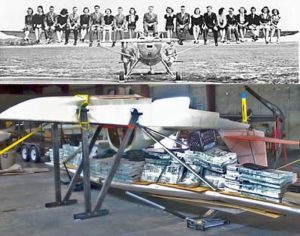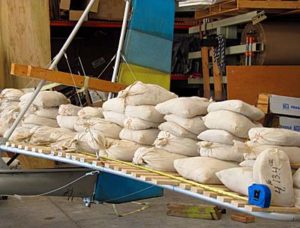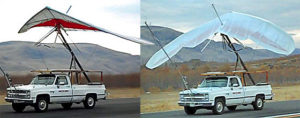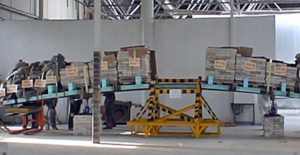
The top photo of a Luscomb is a promotional photo but does show quite a load on the wing. The lower photo is a Searey undergoing load testing. The wing is inverted for positive load application.
Most pilots never probably have witnessed the testing a wing endures before designers and regulators will sign off on it, signaling that it has been adequately stressed so that pilots can depend on it. I’ve had the chance to see several such tests and will state that it is two things: demanding and, well …boring (unless something breaks).
Of course, I don’t mean to demean the hard work it takes. Look at the images in this article and you can see that just to set up a wing for testing can involve literally days if not weeks of work. A fixture, sometimes called a “strongbox,” must be built or obtained. An actual wing must be affixed to the structure. Weights in some form — and a lot of them — must be secured to the wing to assure loads are applied in a real simulation; air loads are not uniform across the wing’s span. Loading the wing is a precise task if engineers are to replicate the forces air loads will place on a wing in flight.
No one takes this casually. Lives can depend on it. A company’s long-term survival may depend on doing the testing correctly and documenting the results thoroughly. The process is typically captured in photos and video and a detailed written technical report must be available to authorities or insurance companies that care deeply that the testing meets standards such as ASTM or FAA certification.

Images shows the Lockwood Aircraft Drifter in load testing. Note the tape measure used to position loads accurately. Wood is used to spread the load across the tubing structure after the Dacron covering has been removed.
No matter how seriously this effort is taken or how much is spent (in time and money) to achieve it, the testing of an aircraft wing is a largely static event.
Naturally, should a wing fails under heavy loads — just look at the immense amount of weight placed on the C4 wing — the test can become very exciting. Things can pop (loudly) and parts may go flying if the wing collapses. No one should stand nearby during an ultimate load test. However, if no failure is witnessed, the wing structure may groan and tremble but nothing much happens. As I said, the test is important, but visually dull.
Yet this is not the case with hang glider wing testing. The difference is captioned in the terms commonly used to describe the tests. An airplane wing is statically load tested where the flex wing hang glider is dynamically tested. The latter method is used because it is a proven real-environment way to simulate the loads on a flex wing.
The dynamic process was developed many years ago by HGMA, the Hang Gliding Manufacturers Association. Some very smart people worked out the techniques and equipment and, to their credit, hang glider wings can bear an immense load and not fail, even when upside down.
An airplane manufacturer — let’s say of a 2,500-pound aircraft — cannot imitate the dynamic test used by a hang glider or trike wing manufacturer. Testing a metal or composite wing for a larger, faster airplane would take an extraordinarily powerful vehicle, and it would have to go very fast. However, the slower speed and lower mass of hang gliders makes dynamic testing achievable. To perform the required tests on its creations, North Wing has fitted a vehicle with a very sturdy steel structure. Cameras and recording gear are mounted.
It’s worth noting that North Wing is not required to do this by FAA or other regulatory bodies in the USA. Part 103 vehicles do not have to meet government standards. These manufacturers spend the effort because other entities require it and because they want their products to find ready customers who will not buy a glider they doubt can withstand real use. Besides satisfying their customers, insurance companies, media reporters, trial lawyers and others may demand test documentation in case an accident occurs.
The hang glider community has long policed itself and done so in such a professional fashion that FAA almost ignores them. Indeed, when is the last time you heard about a hang glider or trike wing folding up in flight? It almost never happens anymore. Good for HGMA and the hang gliding and flex wing industry.

North Wing’s dynamic load testing of an earlier cable-braced model. The right image is what’s called the Negative 150 test, a difficult load for the wing to bear.
The test shows a positive load applied (wing in normal orientation) and the very demanding “negative 150” test. This simulates a wing that may be disturbed by violent air. The wing is mounted backwards at the appropriate angle and the heavy truck forces the wing through the air backwards in this tortuous test. As you can see, it bowed deeply but survived.
The video below shows dynamic testing North Wing did to prove their new carbon fiber structure Freedom X wing. This is North Wing’s newest product. Besides hang gliders, North Wing makes a line of weight-shift trikes and is a leading supplier of wings to other trike carriage producers.
Freedom X 160 (the wing square footage) uses carbon fiber leading edges and struts and other design parameters to stretch the performance of their Freedom model series. Despite using exotic materials, Freedom X is an exposed-crossbar design, sought after because it has lighter, more responsive handling compared to full double-surface designs. “It’s also quieter than the cable-braced version; you can actually hear it pass through air more smoothly,” said designer and North Wing boss, Kamron Blevins. The structure also contributes to Freedom X’s safety in unusual attitudes, as proven in this testing.
When a pilot takes off at the end of the clip, you almost breathe a sigh of relief at what is obviously far less load than North Wing subjected their newest creation to atop the big truck. Good job, Kamron and team!



Leave a Reply